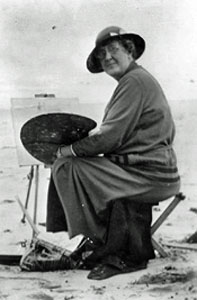
Early Education and European Influence
Mabel May's formal art education began at the age of twenty-five when she enrolled in classes at the Montreal Museum of Fine Arts under the tutelage of William Brymner. From 1909 to 1912, Brymner's instruction proved invaluable, guiding May through the foundational aspects of her craft and encouraging her to explore her creative potential. Her hard work and dedication paid off when she was awarded scholarships for two consecutive years to continue her studies.
After completing her education in Montreal, May embarked on a transformative journey to Europe, accompanied by fellow artist Emily Coonan. In Paris, they immersed themselves in the vibrant art scene, sketching, visiting exhibitions, and studying the works of the Impressionists. May was particularly drawn to the works of Monet, Renoir, and Matisse, whose influence became evident in her subsequent work. This period of European exposure played a crucial role in shaping her artistic style, blending the subtle nuances of Impressionism with her own unique vision.
Artistic Evolution and Contributions
Upon her return to Montreal in 1913, Mabel May's work began to reflect the influence of the French Impressionists. One of her notable works from this period, "Immigrants, Bonaventure Station," showcased her ability to capture the bustling life of the city with a keen eye for detail and a vibrant color palette. Another significant piece, "The Market Under The Trees," acquired by the National Gallery of Canada in 1913, further demonstrated her mastery of the Impressionist style.
In 1916, May was elected an Associate of the Royal Canadian Academy, solidifying her position within the Canadian art community. Two years later, she contributed to the Canadian War Memorials by painting scenes of women engaged in the war effort, specifically those involved in the production of munitions. These works highlighted her ability to depict the strength and resilience of women during a tumultuous period in history.
The 1920s saw the emergence of a vibrant community of women artists in Montreal, many of whom had studied under Brymner. Mabel May, along with Nora Collyer, Emily Coonan, Prudence Heward, and others, formed the Beaver Hall Hill Group, a collective of artists who shared studio space and ideas. This group, although short-lived, played a significant role in advancing the presence of women in the Canadian art scene.

Later Career and Legacy
Mabel May's artistic journey continued to evolve as she painted alongside notable artists such as A.Y. Jackson, Edwin Holgate, and the Gagnons at Baie St. Paul in 1924. By 1925, her work began to show the influence of the Group of Seven, as seen in her painting "Melting Snow." In 1933, she became a founding member of the Canadian Group of Painters, further cementing her role as a key figure in Canadian art.
In 1938, May took on the role of supervisor of children's classes at the National Gallery of Canada in Ottawa. Her teaching methods were well-received, and she inspired a new generation of Canadian artists. During her time in Ottawa, she also lectured on children's art and continued to exhibit her own work, showcasing her evolving style and deepening understanding of form and color.
In 1950, Mabel May held a retrospective exhibition in Vancouver, where she had decided to retire. The Montreal Star praised her work, noting her "intense feeling for the Canadian scene" and her ability to convey the beauty and complexity of the world around her. Although she chose not to follow the Group of Seven into the wilderness, her work remained deeply connected to the Canadian landscape and its people.
Mabel May passed away in 1971 at the age of eighty-seven, leaving behind a rich legacy that continues to inspire artists and art enthusiasts alike. Her work is represented in major collections across Canada, including the National Gallery of Canada, the Art Gallery of Ontario, and the Vancouver Art Gallery. Throughout her career, she won numerous awards, including the Jessie Dow Prize and several scholarships, recognizing her contributions to Canadian art.
Mabel May's life and work stand as a testament to her dedication, skill, and unwavering commitment to her craft. As a pioneering force in Canadian art, she paved the way for future generations of women artists and left an enduring mark on the cultural landscape of the nation.
Browse our collection of Canadian paintings for sale at the Canadian Classic Fine Art gallery, The best place to buy a painting online. We provide free shipping anywhere in Canada and the United States. Our Montreal art gallery sells paintings online exclusively and have a 14 days return policy.
